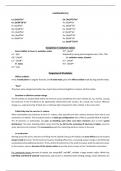Summary
Summary - CHEM0030- Inorganic Chemistry
- Module
- CHEM0030
- Institution
- University College London (UCL)
The document provides an in-depth exploration of the lanthanide series, providing everything you need to pass the exam, covering their unique chemical properties, oxidation states, electron configurations, and the lanthanide contraction. It explains how lanthanides are extracted from ores and sepa...
[Show more]



